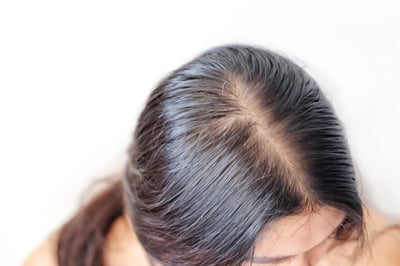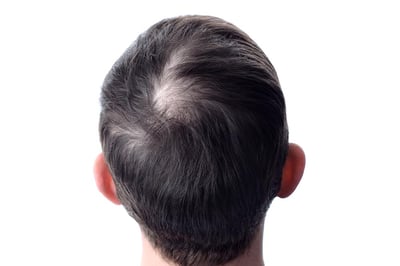Different Alopecia Types

Getting diagnosed with alopecia is a devastating reality millions of women face. It feels like your world has just come crashing down. You feel lost, defeated, and face the shocking reality that you’re likely going to lose more hair. Sure, you finally have an answer to your unexplained hair loss after months—or years—without answers. But it doesn’t help that there are 13 types of alopecia, and isolating your exact type is incredibly challenging.
However, you now have a general diagnosis you can work with, which means, it’s time to take action and find aligned treatment options.
Your first step? Learning about the types of alopecia so you can better understand your condition, and how to treat it.
what are the different types of alopecia?

There are 13 types of alopecia, each caused by various circumstances and exhibiting unique symptoms. Many share symptoms: hair thinning, clumps, or round, balding patches.
However, every woman’s body is unique, meaning even two women with the same type of alopecia may experience hair loss differently.
Alopecia Areata
Alopecia areata is one of two alopecia types that fall under the umbrella term alopecia.
Autoimmune diseases result from your body mistakenly attacking healthy cells. Alopecia areata works similarly as an autoimmune disease, except it's concentrated to your hair follicles (sometimes your nails too). You’ll also see that alopecia areata has several subtypes (more on those later).
Your hair follicles undergo four different phases in the hair growth cycle. If you have alopecia areata, your cells attack your hair follicles and force them into a premature move from the anagen (growth) phase to the catagen phase, where they shrink and slow down.
Scientists and medical researchers speculate stress, genetics, certain vaccines, infections, and medications could all cause alopecia areata.
The most common symptom of alopecia areata is patchy round spots, and the onset occurs quickly. A doctor will likely first prescribe you corticosteroids, either oral, topical, or in some cases, injected. If that doesn’t work, you might consider using topical Minoxidil or anthralin, a medication for psoriasis.
Androgenetic Alopecia
The second alopecia type falling under the general category of “alopecia” is androgenetic alopecia, also called male/female pattern baldness, genetic hair loss, or pattern alopecia. Androgenetic alopecia is the most common of the 13 types of alopecia.
But they all mean the same thing: hair loss occurs as a genetic response. This type of alopecia typically has a more gradual onset than alopecia areata, but that doesn’t make it any less devastating.
Caucasians tend to experience androgenetic alopecia more than people of color, though Asians and African Americans also experience genetic hair loss. Medical experts point to an abnormal bodily response to androgens as the root cause, leading to follicular miniaturization—follicles miniaturize and shrink over time, resulting in hair loss.
However, hormonal imbalances are also at play.
Lifestyle changes can temporarily help, but they won’t treat the condition. The best solution is to use a hair loss drug like Finasteride or Minoxidil — if that doesn’t work, you may want to consider concealing hair loss. A natural 100% human hair wig blends with your bio hair, giving you confidence as you navigate your hair loss.
Female Pattern Baldness
 Genetic hair loss could manifest at any time, even as early as just after puberty. Approximately 40% of women will experience female pattern baldness by 50, though some experts suggest as many as 50%.
Genetic hair loss could manifest at any time, even as early as just after puberty. Approximately 40% of women will experience female pattern baldness by 50, though some experts suggest as many as 50%.
Do you notice a widening gap where your hair parts? That’s the most common symptom of androgenetic alopecia in women. Additionally, you might notice more thinning and hair loss on the crown and top of your head.
Male Pattern Baldness
 Genetics are also the leading cause of men’s hair loss. Men with androgenetic alopecia will notice hair thinning and loss at the highest part of their scalp, also known as the vertex. It’s also common to manifest at the middle point of your head (frontotemporal region).
Genetics are also the leading cause of men’s hair loss. Men with androgenetic alopecia will notice hair thinning and loss at the highest part of their scalp, also known as the vertex. It’s also common to manifest at the middle point of your head (frontotemporal region).
While men might have luck with Minoxidil or Finasteride as a treatment, they’re more likely than women to try hair transplant surgery if they have enough donor hairs.
Genetics play an important role in all androgenetic alopecia cases, especially for men. You’re five times more likely to develop it if you’re a man with a balding father.
Does this mean all types of alopecia are genetic? It certainly accounts for a large portion of hair loss, but not all hair loss.
Traction Alopecia
If you wear your hair in cornrows, goddess braids, or tight ponytails, you might be at higher risk for traction alopecia – the only one of our alopecia types caused solely by tight hairstyles that tug at the hair follicles. African American women are the largest demographic for traction alopecia. No one can deny the beauty of Naomi Campbell’s braids, but the model says the tight style contributed to her traction alopecia.
Men can also develop traction alopecia. Bicycle helmets, hats, dreadlocks, cornrows, and man-buns can all cause friction against the follicles, tugging and pulling on them until hair loss occurs as a result.
Another condition is called trichotillomania, a psychiatric disorder where one pulls out their own hair, which can lead to traction alopecia.
The best solution? Relax your hair with looser styles, give the follicles a breather, and you could reverse the effects of traction alopecia.
While you’re at it, you might want to take some time to de-stress. Sip on a peppermint tea or try a meditation video — whatever beats the stress, because it could lead to this next form of alopecia.
Here’s where it gets tricky:
Most telogen effluvium cases occur three months after a significant stressor. This makes it hard to isolate the specific trigger. Fortunately, your hair can replenish as quickly as six months after reducing the stress trigger.
What are some other types of alopecia areata and how do they manifest?
Persistent patchy alopecia areata
Persistent patchy alopecia areata is alopecia areata kicked into overdrive.
If you experience several coin-sized patches with alopecia areata, the persistent patchy variety results in even more aggressive patches.
The persistent patchy subtype occurs over a long period of time. If you have this advanced alopecia areata, a doctor might recommend more aggressive treatment, like 5% Minoxidil over the 2% solution, or more potent corticosteroid doses.
Alopecia totalis
Some men or women shave their heads to better manage alopecia. A severe alopecia type could result in complete hair loss on the scalp: alopecia totalis.
Did you ever wonder how Matt Lucas from Doctor Who went completely bald? A car accident caused him enough stress to develop alopecia totalis at six years old.
Doctors guess that people with alopecia totalis will likely never regrow their hair if they’ve had it for over two years. Many decide to wear wigs, like our Follea friend, Eline Torgersen.
But as we know, alopecia affects both men and women. Men might wonder if their mustache or goatee is at risk. Our next alopecia type affects more than just scalp hair:
Alopecia universalis
Another severe alopecia areata type, alopecia universalis is complete hair loss — everywhere. Many patients lose their facial hair, leg hair, scalp hair, and even eyebrows. Unfortunately, you’re the least likely to regrow your hair if you have alopecia universalis.
Some medical experts feel optimistic about Vitamin D as a treatment, while others lament most treatment response to AU is short-lived at best. Finally, some experts describe success with:
- Diphenylcyclopropenone
- Squaric acid dibutylester
- Photodynamic therapy
- Steroids
- Cyclosporine and methylprednisolone
Ophiasis alopecia
Hair loss usually occurs in patches or common scalp areas like the hair part and crown. Ophiasis alopecia is a different story. This unique alopecia type manifests in a thick band of hair loss across the scalp’s lower sides and back.
Experts mark this alopecia areata type as resistant to treatment and medication. However, one study found success in a 58-year-old male after microneedling with triamcinolone, a popular corticosteroid for skin conditions and hair loss.
Alopecia barbae
Alopecia barbae is particularly hard on men with beloved beards. Although it causes bald scalp patches, this alopecia type also encompasses beard hair. Most of the time alopecia barbae develops along with alopecia areata. Other causes include chemotherapy and ringworm.
Fortunately, this and most alopecia types don’t cause scarring. But that’s not the case for all types of alopecia.
Cicatricial alopecia
Most alopecia demonstrates issues in the hair follicles. Cicatricial alopecia, also known as scarring alopecia,is characterized by fibrous tissue that replaces your follicles.
That tissue completely blocks hair from growing back, making it irreversible. Most treatment plans focus on retaining existing hair and preventing further patches.
Is cicatricial alopecia genetic? Sometimes, but its most common form is suspected to stem from lifestyle choices in your hair routine.
Central centrifugal cicatricial alopecia (CCCA)
Medical experts suspect hot combs, weaves, and relaxers cause central centrifugal cicatricial alopecia (most commonly scarring alopecia). Middle-aged women are the majority of patients, with the condition affecting more Black women than other types of hair loss.
Other culprits behind this scarring alopecia might include Type 2 diabetes, fungal infections, and autoimmune disease.
Lichen planopilaris
Lichen planus is a medical condition that causes scaly skin and interrupted mucous membranes. When it affects your scalp and hair follicles, lichen planopilaris is a form of that same condition.
The symptoms are difficult to manage — red scalp bumps gather around your hair clusters and cause scarring, and permanent hair loss.
Our final alopecia type is a subset of lichen planopilaris:
Frontal fibrosing alopecia
If you have lichen planopilaris situated near your forehead, you might have frontal fibrosing alopecia. Like lichen planopilaris, this subtype requires more studies for doctors to determine the exact cause. In some cases, the scarring could spread to your eyebrows and other body parts.
Now, let’s explore the last in our list of alopecia types.
Postpartum Alopecia
Having a baby takes a significant physical toll on women, and so does the aftermath. Many women experience postpartum depression shortly after giving birth, but a less-talked-about hormonal change is postpartum alopecia.
The main cause is a sharp drop in estrogen levels. Although postpartum hair loss is temporary, it’s not ideal as you care for your infant and your body adjusts to the physical shock it’s just been through. Your hair should return to normal in a few months as your hormone levels recalibrate.
Many women want to take a proactive approach, which leads us to finding the best treatments for alopecia.
what is the best treatment for alopecia?
Of course, the best treatment is catered to your specific alopecia type. For example, looser hairstyles are your best bet for traction alopecia, but not so much for androgenetic alopecia.
Here, we’ll share the best alopecia treatments to help you take control of your hair loss.
Minoxidil
Could you actually reverse genetic hair loss? Perhaps not immediately, but many women have had luck with Minoxidil — one of the FDA’s two approved drugs for androgenetic alopecia. The topical drug takes 6-9 months to work, but only if you have the right scalp enzyme activity to activate it.
Thanks to Daniel Alain’s innovative team of researchers, you don’t have to wait any longer to find out if Minoxidil will work for you. All you have to do is order our Minoxidil Response Test (MRT) to get fast results you can trust.
Worst case? Minoxidil isn’t for you. Then, you can move on quickly to pursue other hair loss solutions.
Finasteride
You might better recognize this hair loss drug as Propecia, its most common brand-name version.
Men and post-menopausal women are the top candidates for Finasteride, as the drug isn’t FDA-approved for women yet due to pregnancy risks. Specifically, men have better luck with Finasteride than Minoxidil — but the side effects can feel costly. Some studies report erectile dysfunction and depression as common accompaniments to your newly regrown hair.
Maybe you’re not one for hair loss drugs. In that case, you might consider a cosmetic solution to help retain your existing strands.
INTACT Anti-Hair Shedding Treatment
Daniel Alain’s INTACT hair fall treatment is the perfect, non-invasive way to retain existing hairs. While you might have said goodbye to some strands, you can protect the rest with our patented PiliLock® Sevilla Orange Complex. Its unique formula grips your hair and keeps it secure even during high-shedding activities like washing, brushing, and styling.
If you’re short on time, you’ll love INTACT’s quick effects. All you need is 30 minutes to see results! Want to find fabulous hair even faster?
Find a solution for alopecia at daniel alain
Knowing the type of alopecia you’re experiencing is the first step to getting on the right treatment path.
Despite the various types of alopecia, none of them are hopeless. You always have choices, even if those options feel distant at the moment, they are available.
Daniel Alain offers only the best in hair loss solutions. Scientifically studied hair retention treatments, clinically proven genetic tests, and 100% human hair wigs are incredible ways to overcome any alopecia type.
Are you ready to take control? Schedule a consultation with one of our hair stylists today!
book a free consultation
Our stylists will help you find the right hair loss solution just for you

Frequently Asked Questions
What is the Most Common Type of Alopecia?
Androgenetic alopecia is the most common type of alopecia, also known as genetic hair loss or male/female pattern baldness.
How Common is Alopecia in Men?
Alopecia affects approximately 50 million men in the US and is estimated to affect 50% of men at some point in their lives.
How Common is Alopecia in Women?
Alopecia affects approximately 30 million women in the US.
What Causes Alopecia?
Different types of alopecia have various causes. For example, tight hairstyles cause traction alopecia, while genetics cause androgenetic alopecia.
How Do I Know What Type of Alopecia I Have?
Most types of alopecia have similar symptoms, like sudden hair loss and patches. However, the best way to diagnose your specific type of alopecia is to consult a dermatologist. Additionally, you might consider trying Daniel Alain’s first-ever genetic hair loss test to determine whether you have androgenetic alopecia.
What are the Stages of Alopecia?
There isn’t a set of stages for alopecia. It affects everyone differently, but it usually starts with hair thinning and sudden hair loss. Certain types of alopecia could develop into complete hair loss on the scalp (alopecia totalis).
What are the Symptoms of Alopecia?
The most common symptoms of alopecia include widening hair parts, patches, sudden hair loss, hair thinning, and red or brittle nails.
Is Alopecia Life Threatening?
No, alopecia itself isn’t a life-threatening disease. However, the stress it causes might cause psychological trauma.
Is Alopecia a Type of Cancer?
No, alopecia isn’t a type of cancer. However, cancer can cause hair thinning and loss during the course of the disease as well as through chemotherapy treatment.
How Do You Stop Alopecia From Spreading?
The best way to minimize alopecia symptoms is to address it promptly and learn more about the specific types of alopecia. Other measures you can take include:
- Practicing a solid hair hygiene routine
- Reducing stress
- Limiting tight hairstyles
- Maintaining a balanced diet and exercise routine
Does Alopecia Worsen with Age?
While alopecia can happen at any age, you’re more prone to losing your hair after 50. Hormonal changes and aging itself takes a toll on your hair, which could exacerbate alopecia.
Is Alopecia Caused by Stress?
One form of alopecia called telogen effluvium is caused by stress. It’s important to note that you might not even be aware of the stress. For example, a big life transition, crash diet, or mental trauma could all stress you out enough to cause telogen effluvium.
Is Alopecia Life Threatening?
No—alopecia is not life-threatening. However, it can be emotionally distressing for some people and may lead to mental health issues. If you're struggling to cope with your hair loss, wearing a wig or a topper can help you feel more comfortable in your own skin.
Who Is at Risk of Alopecia?
Different types of alopecia hair loss are more common amongst certain groups. For example, Black women are more at risk for traction alopecia due to cultural hairstyles like cornrows and dreadlocks. Additionally, Caucasians are more prone to androgenetic alopecia.
Do Vitamins Have Alopecia?
Vitamin deficiencies in Vitamin D, for example, could lead to hair loss. But vitamins themselves don’t cause alopecia.
How Often Should You Wash Your Hair if You Have Alopecia?
Although washing is a high-shedding activity, experts don’t recommend limiting your showers if you have alopecia. One dermatologist recommends washing your hair just as often as usual, if not more often, to ensure a healthy scalp, free of flakes and itching. Additionally, she recommends limiting shampoo to your scalp area — avoid scrubbing it into the length of your hair.
What is the Fastest Way to Cure Alopecia?
Some types of alopecia don’t have a cure, like androgenetic alopecia. However, the quickest way to mitigate symptoms is to consult a dermatologist on measures you can take. You might want to reduce stress and maintain a healthy hair hygiene routine, to start.
Can Your Hair Grow Back if You Have Alopecia?
In many cases, your hair won’t grow back if you have a genetic form of alopecia. However, you might regrow your hair with medical treatment like Minoxidil or autoimmune meds.
How Many Types of Alopecia are There?
We’ve covered 13 types of alopecia in this article, though other medical conditions and environmental factors can still lead to hair loss symptoms.
What Type of Doctor Treats Alopecia?
A dermatologist is well-equipped to advise people with alopecia.

